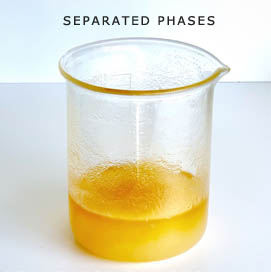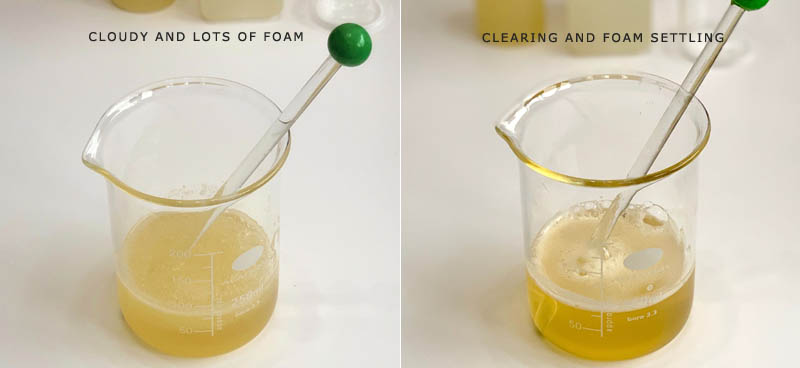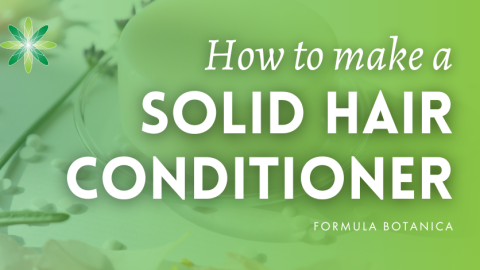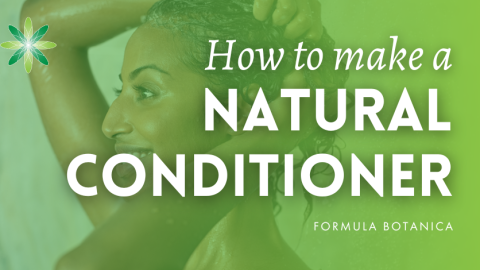Updated: 19.03.24
In this post, we are going to show you how to make a herbal natural shampoo with aromatic rosemary and peppermint hydrosols. This is a simple, easy-to-follow formula but before we begin creating our shampoo, let’s get familiar with the main ingredient types.
Choosing and Using Surfactants
Surfactants, or in other words Surface Active Agents, are widely used in many industries including personal care. You might understand surfactants as the ingredients responsible for making a shampoo or a shower gel foam and cleanse. This assessment is partly correct, although not always the case.
In this post, we will not be able to go into the science of surfactants in detail, but let us cover some basics so you have a grasp of how they fit into our formulation covering how to make herbal shampoo.
A surfactant molecule has a water-loving head and an oil-loving tail. Surfactants can be classified as anionic, cationic, non-ionic and amphoteric depending mainly on the charge of the water-loving head.
- Anionic (has a negative charge) – such as soap, which has strong cleansing properties.
- Cationic (has a positive charge) – such as Emulsense HC (INCI: Brassicyl Isoleucinate Esylate (and) Brassica Alcohol) which is often used in conditioning products, for example hair conditioner.
- Non-ionic (has no charge) – such as Coco-glucoside which tends to be mild and gentle.
- Amphoteric (the charge is dependent on the pH) – such as Cocamydopropyl betaine which can behave as an anionic or as a cationic surfactant depending on the pH.
Emulsifiers and solubilisers both belong to the surfactant group. I am sure you have noticed that when you want to solubilise some essential oils in your facial toner your formula may foam a little. That is because a solubiliser is effectively a surfactant.
Of course, there is so much more to know about surfactants, this barely scratches the surface. We teach surfactant science in our Advanced Diploma in Organic Cosmetic Science and in our Diploma in Organic Haircare Formulation.
In learning how to make natural shampoo, one of the first, most important decisions will be your choice of surfactant as that will dictate the base of your product. When blending your surfactants with water or hydrosols, you will end up with a low viscosity product. This would only be a aesthetically pleasing and practical if you opt for a foamer bottle to dispense the product as these containers have a special chamber that transforms your watery base into a foam.

If you have ever tried thickening your products with gums, you may have ended up at times with either a gooey blend or a separated mess instead of a lovely, transparent and thick product.
Here, we show you how you can achieve a clear blend with a good flow without using a gum.
By following our advice, you won’t need to worry about separated phases.
The base of your natural shampoo
We are using various surfactants to create our base. You can use one surfactant only, but your product will perform better if you blend surfactants. As with other ingredient groups, not all surfactants are equal.
- Lauryl glucoside is a non-ionic surfactant in the form of a thick, white paste. It is compatible with other surfactants and it needs to be heated until it becomes clear.
- SCI or Sodium Cocoyl Isethionate is a coconut-derived surfactant in the form of powder or flakes. This surfactant is used in shampoo or shower bars a lot. This will need to be melted.
- Decyl glucoside is a non-ionic surfactant with good foaming properties.
We will also be using Lamesoft PO65 (INCI: Glyceryl Oleate (and) Coco-Glucoside) which is a lipid layer enhancer or refatting agent. This means it will help with moisturising and has softening properties.
With these surfactants, we will be using two aromatic hydrosols: peppermint and rosemary. Both of these plants are excellent in shampoos. Peppermint is cooling and refreshing while rosemary may help with circulation and potentially therefore slow down hair loss.
Active ingredients in your natural shampoo
Now we’ve covered the basics of how to make an organic shampoo, we can take a look at some of the many active ingredients you can add. Because of course, a good shampoo is not just a blend of water and surfactants. We will be adding some other ingredients to create a product that has good cleansing properties as well as being nourishing and leaving your hair nice and soft.
1. Proteins: we use hydrolysed rice and hydrolysed wheat protein in our shampoo which are excellent at moisturising the hair or even skin. They have film-forming properties which help protect the hair cuticles and they make hair feel soft and hydrated. The hydrolysis means that the protein is broken down into smaller molecules so they can penetrate the cuticle.
(Hydrolysed Rice protein – INCI: Aqua, hydrolysed rice protein, sodium benzoate. Wheat protein – INCI: hydrolysed wheat protein, sodium benzoate.)
2. Hair Protect: we use an algae extract which excels in shampoos and conditioners at providing shine and moisture protection to the hair. It is also great in styling products where heat protection is needed.
(INCI: Aqua, glycerin, cystoseira compressa extract, zea mays starch, dehydroacetic acid, benzyl alcohol, sodium benzoate, gluconolactone, calcium gluconate.)
Now that you are familiar with the main ingredients, let’s find out how to make a natural shampoo.
Our Formula: Natural Mint & Rosemary Shampoo
Makes: recommended trial batch size: approx. 100-300g.
Formulation: a mainly cold-blended formulation with some warm melting required.
Time taken: 30 minutes.
Level: beginner/intermediate-level formulation to personalise and adapt.
| Phase | Ingredients | INCI | Weight (g) |
| A | Lauryl glucoside | Lauryl glucoside | 25.00 |
| A | Sodium cocoyl isethioniate powder | Sodium cocoyl isethioniate | 5.00 |
| A | Decyl glucoside | Decyl glucoside | 5.00 |
| A | Lamesoft PO65 | Coco-glucoside [and] Glyceryl oleate | 3.00 |
| B | Peppermint hydrosol | Mentha piperata leaf water | 29.50 |
| B | Rosemary hydrosol | Rosmarinus officilis leaf water | 20.00 |
| B | Dermofeel PA3 (chelator) | Sodium phytate, Aqua [and] Alcohol | 0.10 |
| B | Glycerin | Glycerin | 5.00 |
| B | Panthenol | Panthenol [and] Aqua | 2.00 |
| C | Hydrolysed rice protein | Aqua, hydrolysed rice protein [and] sodium benzoate | 1.50 |
| C | Hydrolysed wheat protein | Hydrolysed wheat protein [and] sodium benzoate | 1.50 |
| C | Hair Protect (algae extract) | Aqua, Glycerin, Cystoseira compressa extract, Zea mays starch, Dehydroacetic acid, Benzyl alcohol, Sodium benzoate, Gluconolactone [and] Calcium gluconate | 1.00 |
| D | Preservative Eco | Benzyl alcohol, Salicylic acid, Glycerin [and] Sorbic acid | 1.00 |
| D | Grapefruit essential oil | Citrus paradisi seed oil | 0.40 |
| Total: 100.00 |
Equipment:
- Scales
- Stainless steel bowls
- Stainless steel spoons
- Glass beakers
- Glass rods
- Silicone spatula
- Water bath or bain marie
- Protective gloves
- Suitable container
Method of Manufacture: Mint and rosemary shampoo
- Preparation
Sanitise your utensils and work area, and wear appropriate personal protective equipment and follow Good Manufacturing Practice. (Not sure how? Enrol for Formula Botanica’s Diploma in Organic Skincare Formulation).
- Weigh, heat and blend the surfactants
We are going to weigh out and blend all the surfactants (Phase A ingredients). In a disinfected glass beaker weigh the Lauryl glucoside. Then, add the Sodium cocoyl isethioniate powder. Please make sure you wear a mask so you don’t breathe in the fine powder. Add the Decyl glucoside and finally, add the Lamesoft. Heat the surfactants gently in a water bath and stir occasionally ensuring you stir gently to avoid creating a lot of foam.
- Water-soluble ingredient phase
While the surfactants are melting, weigh the water-soluble (Phase B) ingredients in another beaker.
- Cool the surfactant blend
When the surfactants are melted and translucent, remove from the water bath and let them cool a bit.
- Blend water-soluble ingredients with the surfactants
Add the hydrosol blend (Phase B) to the surfactant blend (Phase A) and stir slowly but thoroughly. You will find the blend to be quite runny, but it will thicken as it cools.
- Add active ingredients
Add all the high-performance additives (Phase C ingredients) to the shampoo base. Stir it well, but slowly to avoid creating a lot of foam.
- Check pH
Check the pH and adjust it to around pH 5.5 if needed. The pH is too high so we will lower it with lactic acid to pH 5.5.
- Add preservative and essential oil
The pH is now 5.5, so we can add our preservative. Add the Preservative Eco and finally, add the grapefruit essential oil, stirring in gently but thoroughly.
- Decant and bottle
Decant into a suitable container after 24 hours (see tips below), label with name, date and batch number.
Formulation tips: Mint and rosemary shampoo
When the shampoo is just formulated, you will see it has a lot of foam. Keep the blend in the beaker for a while and the foam will settle down within 24 hours. It will also become clear which is very pleasing to look at. Once it has clarified and become translucent, transfer it into a suitable container and label.
Now you’ve learned the theory on how to make a natural herbal shampoo, it’s your turn to try out the formula and customise it if you wish with your own choice of surfactants and hydrosols. Leave us a comment below to tell us how you got on and how it performs.
If you have enjoyed this post on how to make herbal shampoo, you might also like to read these posts covering other natural haircare formulations:
How to make an exfoliating pre-shampoo
How to make an organic & natural hair conditioner Green beauty blogger verdicts on natural haircare
Suggested suppliers
Many of the suppliers below ship internationally. We indicate their country or regional base.
Aromazone (EU).
Aromantic (UK)
Alexmo Cosmetics (EU)
Manske (EU)
Soap Kitchen (UK)
Elemental (EU)
Lotioncrafter (USA)
Essential Wholesale (USA)
Go Native (New Zealand)
Naturally Balmy (UK)
O&3 – The Oil Family (UK, EU)
Soap & More (Canada)
Handy Made (Slovakia/EU)
FREE TRAINING
Learn how to become an
Organic Skincare Formulator
FREE TRAINING
How to become an
Organic Skincare Entrepreneur
FREE TRAINING
How to become an
Organic Skincare Entrepreneur
Leave us a comment

Timi was a key member of the Formula Botanica team from 2015 to 2020; first as our Education Manager and then as Head of Formulation & Research. You can find out more about the Formula Botanica team here.



























